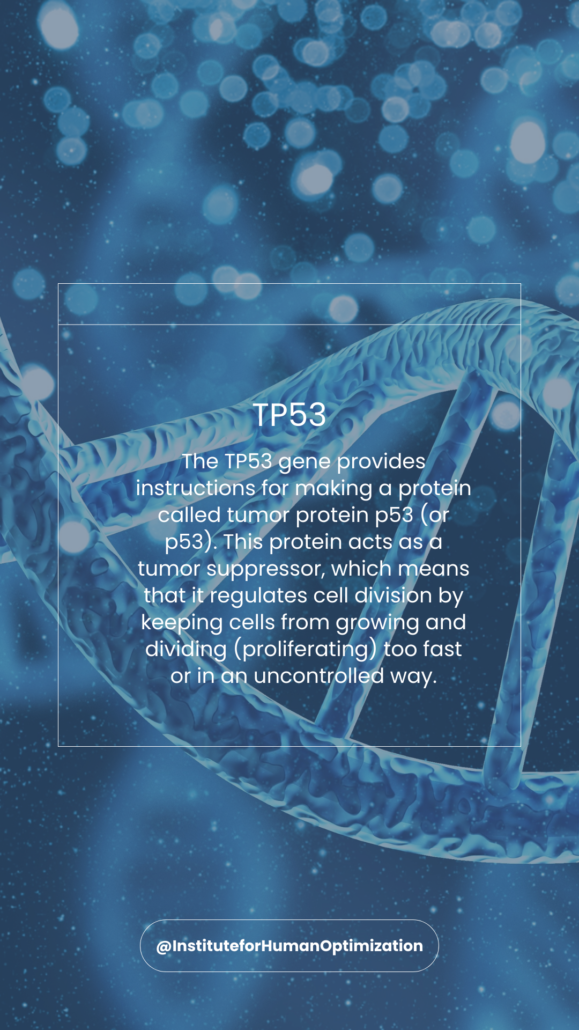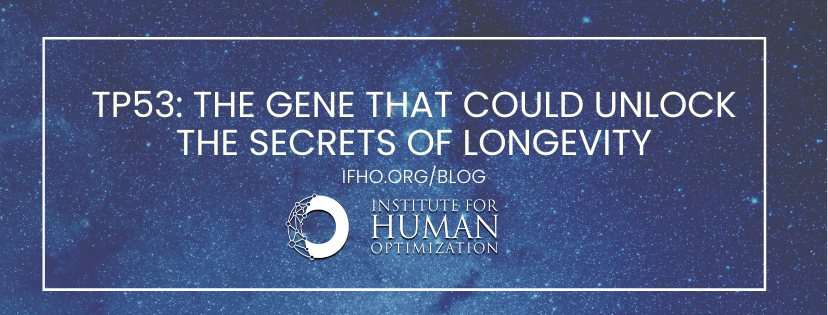TP53: The Gene That Could Unlock the Secrets of Longevity
As our understanding of genomics evolves, we uncover genes that are truly remarkable, both in their intricacy and their implications. TP53 stands as a prime example—an unsung hero and a titan in the field of genomics. With its latest breakthroughs, TP53 might well be the key to unraveling the mysteries of longevity.
In this blog post, we’ll traverse through the landscapes of genetics to understand TP53, its functions, and the groundbreaking research that indicates its role in the quest for longer, healthier lives. Whether you’re a health-conscious reader, a science enthusiast, or simply intrigued by the idea of living well into the future, this is a journey you don’t want to miss.
Genomics: The Prelude to a New Frontier
The field of genomics has long been the frontier of scientific exploration. It’s here, amidst the code of our DNA, that we find the instructions for life. Deciphering this code and understanding its implications has been one of the great pursuits of modern science.
The Human Genome Project, one of the most ambitious scientific efforts in history, marked a turning point in our understanding of genetic makeup. By mapping the entire human genome, it paved the way for a new wave of insights, leading to discoveries that continue to change the landscape of medicine and health.
TP 53: Guardian of the Genome
Within this blueprint, we find TP53—an unassuming gene known for its extraordinary abilities. Dubbed the “guardian of the genome,” TP53 stands sentinel, monitoring cell division to ensure the integrity of our genetic information.
When TP53 senses DNA damage or other aberrations, it halts the cell cycle, giving the cell an opportunity to repair itself. If the damage is irreparable, TP53 can initiate programmed cell death—apoptosis—protecting the organism from potential harm, including cancer.
The role of TP53 doesn’t end there. It also influences a myriad of cellular processes, from metabolism and stress responses to cell differentiation and senescence. Its reach into the mechanisms of aging and longevity is becoming increasingly apparent.

Latest Research on TP53: A Gateway to Longevity
Recent studies have unearthed a new layer of complexity to TP53’s function, showing that it might play a role in longevity. Researchers found that the activity of TP53 declines with age in mammals, including humans. This decline is associated with several aging-related diseases, suggesting that TP53’s vigilance is essential for maintaining vitality as we age.
The link between TP53 and longevity is not just theoretical—it’s tangible. In animal models, activating the gene has been shown to extend lifespan. While it’s not a straightforward path—overactive TP53 can lead to its own set of problems—understanding the delicate balance that TP53 maintains could offer valuable insights into promoting healthspan, the period of life free from disease and disability.
Elephants and TP53: Lessons from the Pachyderm’s Paradox
The longevity of elephants is a natural wonder and a puzzle to scientists. Given that they have 100 times more cells than humans, one might expect them to be particularly prone to cancer. Yet, elephants have a remarkably low incidence of the disease.
Upon closer examination, researchers discovered a surprising aspect of the elephant genome: their TP53 gene is particularly active and effective. It is estimated that elephants carry 20 TP53 genes whereas humans only have one. This extra layer of protection could explain their resistance to cancer and potentially offer insights into anti-cancer therapies for humans.
The elephant’s paradox is not just a matter of curiosity—it holds profound implications for human health and medicine. By studying the genetic adaptations that allow elephants to thrive, we may unlock the key to a future where cancer is a rarity, and our lifespan matches our healthspan.
The Promise of TP53: A Future of Longevity
The collective weight of evidence pointing towards TP53 as a pivotal player in longevity leaves us with a tantalizing prospect: What if we could harness the power of TP53 to extend human life, not just in years, but in the quality of those years?
Emerging technologies, such as CRISPR, offer new tools for genetic interventions. While the ethics and practicalities of such interventions are subjects of ongoing debate, the potential is undeniable. We stand on the cusp of a new era, where our genetic heritage could be edited to prolong youth and health.
In Conclusion: TP53 and The Path Ahead
TP 53 represents not just a gene, but a symbol—a symbol of the intricacy and resilience of the human genome, and the promise it holds for the future. As we continue to delve into the mysteries of our genetic code, TP 53 stands as a guiding light, offering hope and direction in our pursuit of a longer, healthier life.
For those of us keen on living well and living long, the journey with TP 53 has only just begun. As research advances and our understanding deepens, we may find that the key to a future of longevity lies within the very fabric of our being. Embracing this knowledge with prudence, ethics, and an eye towards collective benefit could well be our greatest leap forward in the quest for a fulfilling and enduring life.
Our collective genetic destiny is within our grasp. The question now is, will we unlock the door to a future where age is just a number, and vitality is our birthright? Time will tell, and TP 53 will be there, ever watchful, as we mold our genetic heritage to shape the course of human history.
REFERENCES
- Cancer Genome Atlas Research Network. Comprehensive molecular profiling of lung adenocarcinoma. Nature. 2014 Jul 31;511(7511):543-50. doi: 10.1038/nature13385. Epub 2014 Jul 9. Erratum In: Nature. 2014 Oct 9;514(7521):262. Rogers, K [corrected to Rodgers, K]. Nature. 2018 Jul;559(7715):E12.
- Damineni S, Rao VR, Kumar S, Ravuri RR, Kagitha S, Dunna NR, Digumarthi R, Satti V. Germline mutations of TP53 gene in breast cancer. Tumour Biol. 2014 Sep;35(9):9219-27. doi: 10.1007/s13277-014-2176-6. Epub 2014 Jun 15. Citation on PubMed
- Loyo M, Li RJ, Bettegowda C, Pickering CR, Frederick MJ, Myers JN, Agrawal N. Lessons learned from next-generation sequencing in head and neck cancer. Head Neck. 2013 Mar;35(3):454-63. doi: 10.1002/hed.23100. Epub 2012 Aug 21. Citation on PubMed or Free article on PubMed Central
- Masciari S, Dillon DA, Rath M, Robson M, Weitzel JN, Balmana J, Gruber SB, Ford JM, Euhus D, Lebensohn A, Telli M, Pochebit SM, Lypas G, Garber JE. Breast cancer phenotype in women with TP53 germline mutations: a Li-Fraumeni syndrome consortium effort. Breast Cancer Res Treat. 2012 Jun;133(3):1125-30. doi: 10.1007/s10549-012-1993-9. Epub 2012 Mar 4.
ABOUT THE INSTITUTE FOR HUMAN OPTIMIZATION
Diving into the intricacies of longevity and health optimization often feels like exploring uncharted territories. In Maryland lies a groundbreaking medical practice, The Institute for Human Optimization (IfHO), pioneering the field with a transformational blend of personalized precision medicine, advanced diagnostics, regenerative therapies, cutting-edge research, and an unwavering commitment to the patient’s journey towards their optimal state of being.
At the heart of the Institute for Human Optimization’s success lies a cohesive philosophy that underpins every aspect of its operation. Recognizing that each person is genetically and biochemically unique, IfHO’s approach tailors interventions that are based on the individual. This is more than mere customization; it’s about precision. Here, the comprehensive approach to health is not compartmentalized—it is holistic, factoring in the intricate web of relationships between genetics, environment, nutrition, and behavior.
The Institute for Human Optimization blueprint for optimal health is a symphony of modern science and ancient wisdom. It encourages a proactive stance towards well-being, urging individuals to move beyond mere absence of disease and strive for a life filled with vitality, longevity, and fulfills its potential. This philosophy is the lifeblood of the clinic, shaping the culture and experience one encounters within its walls.
Founded and led by Anil Bajnath, MD, this beacon of optimized healthcare is much more than a mere clinic or center—it represents a fundamental shift in how we approach health and human potential.





Leave a Reply
Want to join the discussion?Feel free to contribute!